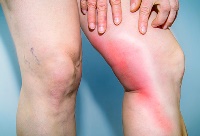
Have you ever experienced leg pain? Did you know that zippered compression socks can be used for preventing and soothing various leg pain?
Continue reading to find out more on how to choose a pair!
Choosing the Best Zippered Compression Socks for You
Zippered compression socks are beneficial for your health as they improve blood circulation in the feet and legs.
Before choosing the best pair for you, consider the following factors first:
1. Size, Fit, and Length
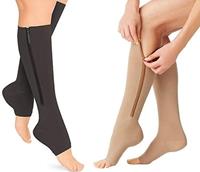
Before making a purchase, if possible, try and test out a pair to see if they fit well on your legs and feet. This kind of socks is designed to give a tighter fit and feel than non-compressed ones, so they should feel snug but comfortable enough for you to still be able to move and carry out your day.
The length that you may decide on can depend on several factors: how many hours in a day do you plan on wearing it? Will you be working out in them? Will you use it only when traveling? A common length is one that is knee-high. These socks are long enough to protect your calves, prevent swelling, and keep you warm.
When it comes to size, measuring your legs and feet would be useful to ensure you purchase the best fitting pair. Continue reading below to understand how you can do this.
2. Ease of Use and Portability
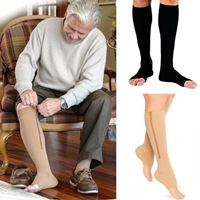
A couple of questions on this zippered feature may come to mind:
How effective is a pair of compression socks with a side zipper? Does the zipper affect its compression? The zipper feature helps the wearer put them on with more ease without affecting the socks compression ability.
In addition, these socks can be brought anywhere and worn anytime. They can simply be folded and stored or packed away. When they are needed, they can be slipped on like normal socks and then zipped up tight.
3. Durability and Material Type and Quality
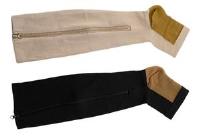
Zippered compression socks can be more costly than regular non-compression socks. This is because of their compression capability and slightly different fabric used.
It is important to consider the material composition of a pair of zippered compression socks.
A good pair is made with a blend of materials to maximize comfort and functionality. Such materials include nylon, cotton, and polyester. Nylon is stretchy and breathable for the skin, whereas polyester feels thin and light. Ensure that you are not allergic to the material used in the compression socks before purchasing a pair.
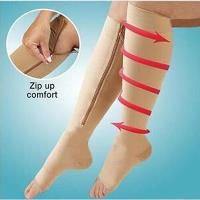
Proper stitching, especially in the heels and toes, will also ensure that the socks is durable for long use.
The zipper, on the other hand, has to be pressure sensitive and made of good material to ensure it does not break easily, such as metal or plastic. Metal zippers can last longer than the plastic kind, but plastic zippers are lighter and more flexible.
4. Compression Level
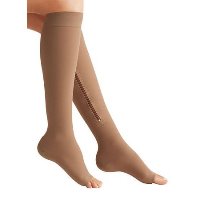
Zippered compression socks are effective in preventing and soothing circulatory issues in the legs, such as swelling, spider veins, varicose veins, and deep vein thrombosis, thanks to their compression feature. They can also help reduce and prevent cramping and clotting as they aid blood flow to the heart.
However, not all zippered compression socks offer the same amount of pressure.
There are generally four different compression levels, measured in ‘millimeters of mercury’ or ‘mmHg’:
- Over-the-Counter (8-15 mmHg & 15-20 mmHg) – Light to medium compression;
- Medical Grade I (20-30 mmHg) – Firm compression;
- Medical Grade II (30-40 mmHg) – Extra firm compression;
- Medical Grade III (40-50 mmHg) – Extra-extra firm compression.
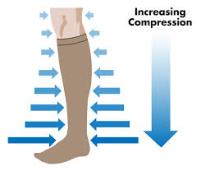
These options should not be overlooked because you may go for a pair that offers lower compression level than what you actually need. when you need a tighter one. It is recommended to consult with a medical health professional on which compression level would best fit you.
Each compression level is aimed for treating different issues; for instance, the 8-15 mmHg compression level would be suitable for warding off fatigue or trying to improve blood circulation in the calves.
Pregnant women experiencing leg fatigue or swelling in the feet may get more effective relief with a compression level of 15-20 mmHg.
Medical grade levels, particularly the 40-50 mmHg level, requires a doctor’s prescription as these are used for severe medical conditions.
Measuring for the Right Size

In order to get proper fitting for, say, ankle-high zippered compression socks, use a measuring tape and measure around the widest part of your calves, then refer to the size guidance below.
| CALF (INCH) | ANKLE (INCH) | LENGTH (INCH) | SIZE (INCH) |
| 9-10 | 6-7 | 16 | MEDIUM |
| 11-13 | 7-9 | 14 or 18 | LARGE |
| 12-14 | 8-10 | 18 | EXTRA LARGE |
| 13-15 | 9-12 | 16 or 18 | XXL |
| 16-18 | 9-12 | 14 or 16 | 3XL |
| 19-20 | 10-13 | 17 | 4XL |
| 21-22 | 12-15 | 18 | 5XL |
| 22-25 | 13-16 | 18 | 6XL |
Also note that our legs may change in size throughout the day, due to water retention; therefore, it is recommended to take measurements later in the day, during the afternoon or evening.
Maintaining Zippered Compression Socks

Zippered compression socks require routine care and maintenance to ensure they last.
It is recommended to wash a pair after every use to prevent skin irritation due to bacteria and sweat build-up in the fabric. The build up of microbes in the socks from prolonged, repeated use can cause infections if they are worn over open wounds on the feet or legs. Proper cleaning is important for your own hygiene as well.
Another tip is to avoid washing them in a washing machine. You can find a brief set of instructions that come with a pair of zippered compression socks, which tend to include a warning on using a washing machine; this can lead to metal rust or breakage for both metal and plastic zippers. It is advisable to hand wash them with cool water and mild soap as detergents can be too harsh for the material.
Also avoid using a dryer, as the high heat could damage the zipper and/or fabric.
Frequently Asked Questions
Q: Does the zipper on compression socks make them less comfortable?
A: It is often assumed that a zipper could cause itching or leave an indentation on the skin. This depends on the manufacturer and their design of their zippered compression socks and how the zipper is incorporated as some zippers probe on the skin while some do not.
Q: Can wearing zippered compression socks all the time cause problems?
A: Anything can be good for you as long as it is used in moderation; constant use of zippered compression socks can bring side effects, especially if you are using one that is a size too small or has a compression level that is stronger than needed. Continuous use can bring discomfort, numbness, aches, and pain. It is recommended to take them off every now and then and should not be worn overnight.
Q: Can I workout in zippered compression socks?
A: Yes. Zippered compression socks are highly recommended for any active individual. For instance, if you experience muscle fatigue during or after an exercise session, using these socks can help quicken recovery. Several other benefits include:
- Prevents swelling,
- Protects joints and muscles and prevents injuries,
- Improves circulation and waste removal.
Q: What compression level would you recommend as the best?
A: As previously mentioned, there are different pressure levels available for different needs. These pressure levels were designed to treat particular health needs and provide certain levels of relief. Therefore, there is no best compression level that is compatible for everyone.
For people who do not have health issues but are looking to reduce minor swelling or improve blood circulation, a pressure level of 8-15 mmHg would be suitable. However, individuals with certain health issues can receive a doctor’s prescription for pressure levels between 20mmHg and 40mmHg.
Q: Can I wear both zippered compression socks and non-compression socks at the same time?
A: If there is a medical reason to, then you can. However, wearing a sock over another can add more pressure to the feet and legs, which can bring discomfort, restricted blood flow, and overheating.
